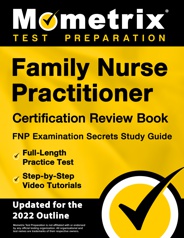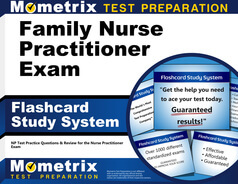The Family Nurse Practitioner (FNP) certification examination was designed by the American Nurses Credentialing Center (ANCC) to provide board certification for individuals who are interested in becoming certified Family Nurse Practitioners.
Click “Start Test” above to take a free Family Nurse Practitioner practice test!
Family Nurse Practitioner Exam Eligibility
To meet the eligibility requirements to take this exam, you will need to have obtained all of the following:
- A master’s, post-graduate certificate, or DNP from an accredited FNP program, with a minimum of 500 faculty-supervised clinical hours
- Three comprehensive graduate-level courses in the following:
- Advanced physiology/pathophysiology
- Advance health assessment, including advanced assessment techniques and assessment of all human systems
- Advanced pharmacology, which includes pharmacodynamics, pharmacokinetics, and pharmacotherapeutics of all broad categories
- Content in the following:
- Health promotion and/or maintenance
- Differential diagnosis and disease management
All of your verification to prove your eligibility must be sent to the ANCC along with a validation of education form before registering for the exam. The proper form and submission documents can be found on the ANCC website.
Family Nurse Practitioner Exam Outline
The FNP exam contains 175 multiple-choice questions, 25 of which are not scored, and you will be given a time limit of 3.5 hours.
The exam is split into five content domains, and each domain contains some number of knowledge questions and skill questions:

I. Assessment (29 scored questions)
The questions in this domain assess your knowledge of evidence-based population health promotion and screening. The following skills are also tested:
- Risk assessment
- Functional assessment
- Physical assessment
- Focused history
- Comprehensive history
II. Diagnosis (26 scored questions)
The questions in this domain assess your knowledge of pathogenesis and clinical manifestations of disease states. The following skills are also tested:
- Differentiation between normal and abnormal physiologic changes
- Diagnostic test selection
- Formulating differential diagnoses
III. Planning (29 scored questions)
The questions in this domain assess your research appraisal skills and your ability to practice with cultural sensitivity. You will also be tested on your knowledge of the following:
- Evidence-based clinical guidelines and care standards
- Age-appropriate preventions
- Pharmacotherapeutics
- Pharmacodynamics
- Pharmacokinetics
- Pharmacogenetics
- Anticipatory guidance
IV. Implementation (43 scored questions)
The questions in this domain assess your therapeutic communication, resource management, and patient education skills, as well as your ability to create comprehensive documentation. You will also be tested on your knowledge of the following:
- Pharmacologic and non-pharmacologic interventions
- Scope and Standards for Advanced Practice Registered Nurses
- Legal and ethical implementations for healthcare and technology
- Regulatory guidelines
V. Evaluation (23 scored questions)
The questions in this domain assess your ability to evaluate, manage, and report test results. You will also be tested on your knowledge of the following:
- Pharmacotherapeutic and non-pharmacologic intervention and treatment outcomes
- Ethical and legal principles and issues for patients, systems, and populations
Useful Topics to Study
The body systems and drug agents listed below are covered in some way on the exam, so you should ensure you are familiar with them.
| Body Systems | Drug Agents |
|
|
Check out Mometrix's Family Nurse Practitioner Study Guide
Get practice questions, video tutorials, and detailed study lessons
Get Your Study Guide
Family Nurse Practitioner Exam Registration
Registering for and scheduling your Family Nurse Practitioner exam can be done online.
The cost of the examination is $395 for all candidates who are not members of the American Nurses Credential Center. Active ANCC members will pay $295 to register for the exam.
Test Day
You should arrive at the testing center 15-30 minutes before the exam is scheduled to begin. When you arrive, you will be asked to provide two forms of identification. Your primary form of ID must include your name, signature, and photo, while the second form of identification must simply have your name and signature.
Personal items such as cell phones, coats, wallets, food/drink, and notes are not allowed in the testing area.
How the Family Nurse Practitioner Exam is Scored
You will be able to see your preliminary scores as soon as you complete the exam. You will have to sign into your AANC account to view your final score report.
You will need to achieve a score of 350 to pass, with the maximum score possible being 500.
Check out Mometrix's Family Nurse Practitioner Flashcards
Get complex subjects broken down into easily understandable concepts
Get Your Flashcards
FNP Test Online Prep Course
If you want to be fully prepared, Mometrix offers an online FNP prep course. The course is designed to provide you with any and every resource you might want while studying. The FNP course includes:
- Review Lessons Covering Every Topic
- 750+ FNP Practice Questions
- Over 80 Video Tutorials
- More than 750 Electronic Flashcards
- Money-back Guarantee
- Free Mobile Access
- and More!
The FNP prep course is designed to help any learner get everything they need to prepare for their FNP exam. Click below to check it out!
FAQs
Q
How many questions are on the ANCC FNP exam?
A
There are 175 multiple-choice questions on the exam, 25 of which are unscored.
Q
How long is the ANCC FNP exam?
A
The time limit for this exam is 3.5 hours.
Q
What is the passing score for the ANCC FNP exam?
A
To pass the exam, you must achieve a scaled score of at last 350.
Q
How much does the ANCC FNP exam cost?
A
The examination fee is $295 for ANCC members and $395 for non-members.


